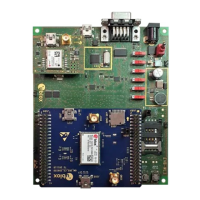SARA-R5 series - System integration manual
UBX-19041356 - R04 Design-in Page 45 of 118
C1-Public
2.2.1.4 Guidelines for VCC supply circuit design using a rechargeable battery
Rechargeable Li-Ion or Li-Pol batteries connected to the VCC pins should meet the following
prerequisites to comply with the module VCC requirements summarized in Table 5:
• Maximum pulse and DC discharge current: the rechargeable Li-Ion battery with its related output
circuit connected to the VCC pins must be capable of delivering the maximum current occurring
during a transmission at maximum Tx power, as specified in SARA-R5 series data sheet [1]. The
maximum discharge current is not always reported in the data sheets of batteries, but the
maximum DC discharge current is typically almost equal to the battery capacity in Amp-hours
divided by 1 hour.
• DC series resistance: the rechargeable Li-Ion battery with its output circuit must be capable of
avoiding a VCC voltage drop below the operating range summarized in Table 5 during
transmission.
2.2.1.5 Guidelines for VCC supply circuit design using a primary battery
The characteristics of a primary (non-rechargeable) battery connected to VCC pins should meet the
following prerequisites to comply with the module VCC requirements summarized in Table 5:
• Maximum pulse and DC discharge current: the non-rechargeable battery with its related output
circuit connected to the VCC pins must be capable of delivering the maximum current
consumption occurring during a transmission at maximum Tx power, as specified in SARA-R5
series data sheet [1]. The maximum discharge current is not always reported in the data sheets of
batteries, but the maximum DC discharge current is typically almost equal to the battery capacity
in Amp-hours divided by 1 hour.
• DC series resistance: the non-rechargeable battery with its output circuit must be capable of
avoiding a VCC voltage drop below the operating range summarized in Table 5 during
transmission.
2.2.1.6 Guidelines for external battery charging circuit
SARA-R5 series modules do not have an on-board charging circuit. Figure 24 provides an example of
a battery charger design, suitable for applications that are Li-Ion (or Li-Pol) battery powered.
In the application circuit, a rechargeable Li-Ion (or Li-Pol) battery cell, that features the correct pulse
and DC discharge current capabilities and the appropriate DC series resistance, is directly connected
to the VCC supply input of the module. Battery charging is completely managed by the battery
charger IC, which from a USB power source (5.0 V typ.), linearly charges the battery in three phases:
• Pre-charge constant current (active when the battery is deeply discharged): the battery is
charged with a low current.
• Fast-charge constant current: the battery is charged with the maximum current, configured by
the value of an external resistor.
• Constant voltage: when the battery voltage reaches the regulated output voltage, the battery
charger IC starts to reduce the current until the charge termination is done. The charging process
ends when the charging current reaches the value configured by an external resistor or when the
charging timer reaches the factory set value.
Using a battery pack with an internal NTC resistor, the battery charger IC can monitor the battery
temperature to protect the battery from operating under unsafe thermal conditions.

